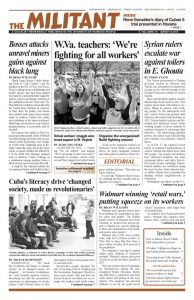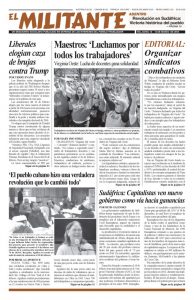“Black Lung Disease Comes Storming Back in Coal Country” read the headline in the Feb. 22 New York Times. They’re talking about a debilitating and deadly disease that had been pushed way back by a powerful battle waged by miners, retirees and family members in the coalfields in the late 1960s and ’70s. This fueled a revolution won in blood by the United Mine Workers of America. In their drive for profits, coal bosses have pushed back gains union miners made in workers control over safety and conditions as the union weakened. Black lung, also known as coal workers’ pneumoconiosis, is irreversible, and often fatal.
Two miners were killed in West Virginia mines this month. James Whitlock was killed doing electrical work on machinery at the Pocahontas Coal Company Devils Fork 2 highwall mine in Raleigh County the same day as the Times report. Leonard Griffith was killed Feb. 6 at the Wolf Run Mining’s Sentinel mine in Barbour County working on a continuous mining machine when a block of coal came loose from the wall.
A study by the National Institute for Occupational Safety and Health at three clinics in southwestern Virginia reports that more than 400 miners were diagnosed with progressive massive fibrosis there over the past four years. This is “the largest cluster of advanced black lung disease ever reported,” National Public Radio reported Feb. 6. In a follow-up study of additional clinics NPR reported nearly 2,000 cases over a similar period.
Nearly a quarter of the miners affected are younger and had been on the job fewer than 20 years. The disease they’ve got is a particularly virulent form.
“We’re seeing things we didn’t see in the 1990s,” Ron Carson, black lung director at Stone Mountain Health Services in southwestern Virginia, told the Militant Feb. 26. “Miners are getting sicker, disabled and their lung volume is decreasing.
“Miners are saying that the easy coal is gone, that we’ve got to drill through so much rock and silica now to get to good coal,” Carson said. “Machinery chops the rock and dust so fine the respirators don’t capture the real fine dust.” Companies are trying to extract more coal “with fewer miners working longer hours.”
In the late 1960s and ’70s, coal miners organized a revolution in their union — the United Mine Workers — to fight against mounting cases of black lung, for safety on the job and to retake control of their union. They faced not just coal bosses who put profits over miners’ lives, and a government that stood with the bosses, but also a corrupt, thug misleadership on top of the United Mine Workers. They set up the Black Lung Association and Miners for Democracy and fought.
Revolution in the union
Many of the fighters were so-called “discards of the industry” — the disabled, the widows, victims of black lung. At the time, a number of the miners in southern West Virginia were Black, including Robert Payne, president of the Disabled Miners and Widows.
They fought with determination and discipline. “We were after something and we got it,” Raymond Wright, a miner and one of the rank-and-file leaders, told the UMW Journal in 2001. “Everyone was sober, everybody was serious. We were so orderly and respectable, we came out on top.”
Miners came behind Jock Yablonski, who ran for president of the union in 1969 in an effort to oust the corrupt Tony Boyle machine. Boyle hired thugs who shot and killed Yablonski, his wife and daughter.
Miners redoubled their fight, forced passage of black lung health care laws, got Boyle jailed and took back their union.
Miners set up union safety committees with the power to shut production — power they used — to enforce safety. Incidents of black lung declined more than 90 percent from the 1970s to the mid-1990s.
Bosses’ counterrevolution
But the bosses pushed back through layoffs and the closure of many union mines. Twenty years ago the union had 240,000 members. In 2015 there were about 10,000 working UMWA members — 21 percent of U.S. coal miners.
Instances of black lung began to rise dramatically. In 2014, a year before his death, Donald Rasmussen, a well-known doctor from southern West Virginia who spent decades helping miners and their union fight black lung, told the Militant, “We’re seeing a very distinct increase in advanced cases that we hadn’t seen in quite a long time. Mining machines have become more powerful. They can cut through rock and this creates silica dust, which is more toxic than coal dust.”
For many diagnosed with black lung, companies put all kinds of roadblocks in the way of miners getting benefits. “Lawyers fight and they fight, companies fight and they fight, they fight so long they hope someone dies,” Steve White, black lung counselor at the Tug River Health Association in Gary, West Virginia, and a former UMWA miner, told the Militant Feb. 26. “I don’t know how many coal miners died before receiving benefits. My dad fought for 15 years and never got it. His check came three days after he was buried.”
“I got breathing problems that doctors say is not caused by black lung,” Randy Hall, a retired miner who worked 21 years at the Jim Walter no. 5 Mine in Brookwood, Alabama, told the Militant. “But they don’t know what’s causing it.”
“I would never work in a nonunion mine because of just safety alone. In union mines, you get backing, strong backing,” he said. “When I was in the mine if I said it was unsafe, I would make it safe, or figure I didn’t have to do it.”

